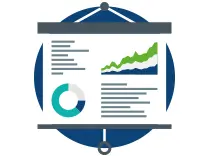
Imagine if, when you talked to a friend on the phone, you forgot everything you knew about them from your interactions over social media, email, or when you met face-to-face. Instead, all you could remember were your past phone calls with this person.
“Technology changes ridiculously quickly these days. The trick is to get the business benefits you need without betting the farm on any particular system or platform”
Most businesses today need to communicate with customers over a number of different channels, including telephone, email, chat, social media, and mobile messaging.
When you’re a small company with just a few customers, you can do this on an ad-hoc basis with just a phone, a PC and a web browser.
The business challenges then are to understand what you need to invest in to deliver your sales, customer service, and customer experience goals, and secondly to minimise those investment costs and stretch the ROI as far as possible.
But doing it on any sort of scale is going to require fairly significant investment in technologies like telephony platforms, CRM software, agent desktops, and digital channel management platforms.
Blame Amazon, Uber and Airbnb
Customers, whether consumers or businesses, have become spoilt. They are now so used to services like Amazon, Uber, Airbnb and other digital leaders, that they discriminate against companies that don’t deliver that level of convenience.
Even if your business is in a sector that isn’t at the forefront of the digital revolution, your customers still expect you to play the digital game.
It’s for this reason that digital transformation and digital disruption have been near the top of most CTO’s and CEO’s worry lists for nearly a decade.
Everyone wants to ride the coattails of some new technology to be the next Uber or Netflix. Nobody wants to get blindsided by some new innovation and go down as the next Kodak.
Betting on Technology is Inherently Risky
Of course, it’s not enough to just be aware of what new technologies are out there. Leading companies are those that actively invest in or develop new technologies and use them to create innovative business models and products.
As products and services have become homogenised, customer experience and service become the biggest differentiators, sometimes even more so than price. Technology is an enabler of differentiation.
But technology changes ridiculously quickly these days. As soon as your company bets its future on some new software or hardware there is likely to be something better, faster, cheaper, or with more capabilities just around the corner.
The trick, then, is to get the business benefits you need without betting the farm on any particular system or platform.
Three Elements of Risk
When it comes to making technology investments, you will always have to make compromises to balance the risk and rewards in the following areas:
- Financial risk dictates how much you are willing to spend and what ROI you need to target over the short, medium, and long-term.
- Technology change risk is how exposed your business is to any piece of technology you use becoming obsolete or getting superseded by something else. If the rate is disruption and innovation in your industry is high, then your risk here is higher. If you are in a more traditional sector then whatever system you buy today may well last you a decade, so your risk is lower.
- Customer experience risk is about deciding what’s the minimum level of service you need to deliver to customers and ensuring you have the means to do that. This will vary from industry to industry and on whether your business and brand rely on you being a digital leader.
How to Mitigate the Risks
There are two models for making business investments: capital expenditure (Capex) and operational expenditure (Opex).
A company that purchases on a Capex model is taking on all the risk that the technology does what it was bought to do, doesn’t go out of date too quickly and has the expected business benefit. The vendor gets paid upfront for the lifetime use of the technology and so the pricing should reflect this.
In an Opex model, the risk is more shared out. The vendor gets paid by use so it’s in their interest to keep the technology up-to-date and continue to add features to retain users. As a purchaser you always have a way out of the relationship if it isn’t working out. While you would expect prices to be higher over a comparable lifetime than with Capex, you would also expect prices to reduce the longer you commit as that means you’re taking on more of the risk.
Pay As You Go
The main advantage of pay-as-you-go is that the company only pays for what it uses, which means no overpaying or under-utilising of resources. Financial risk is lower, and you can stop at any moment.
Technology risk is lower because the vendor is incentivised to keep updating and improving the technology so that you continue to use it, and because you can switch at little to no cost if something better comes along.
Customer experience risk is better as you can almost guarantee that you will have access to the very latest, cloud-based, API-enabled solutions as by their very nature these are the ones most suited to a Pay-as-you-go model.











